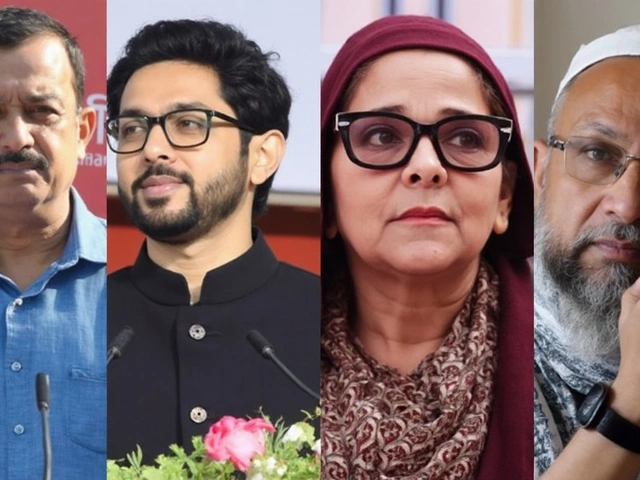
When the final wicket fell at the Sher-e-Bangla National Cricket Stadium on October 23, 2025, the roar wasn’t just for a win—it was for a statement. Bangladesh didn’t just beat West Indies by 179 runs in the third ODI; they buried them under a mountain of spin, silence, and sheer dominance. The series? Sealed 2-1. The margin? Bangladesh’s second-largest ODI victory by runs ever—and their biggest ever against the Caribbean giants.
A Batting Masterclass Built on Fireworks
Bangladesh won the toss, chose to bat, and didn’t look back. The opening pair of Saif Hassan and Soumya Sarkar turned the Powerplay into a carnival. In the first 10 overs, they raced to 74 without loss—no wickets, no fear. Saif, aggressive from ball one, cracked 50 off just 44 deliveries with four fours and four sixes. Soumya matched him, reaching his half-century in 48 balls, his strokes clean and confident. Their 100-run stand came in 93 balls. At drinks, they were still together—54 and 66, the pitch offering no grip, the bowlers offering no answers.The middle order didn’t collapse. It elevated. Even when the last wicket fell at 296/8, the total felt like a fortress. The Dutch-Bangla Bank Bangladesh West Indies ODI Series 2025 wasn’t just sponsored by a bank—it was defined by a nation’s resurgence.
Spin That Broke the Caribbean
West Indies came out looking for a chase. They got a nightmare.By the 26th over, they were 85/8. By the 30th, they were all out for 117. The Bangladesh Cricket Board (BCB)’s home advantage wasn’t just about the crowd—it was about the pitch, the conditions, the spinners who knew exactly how to turn the ball and trap the batsmen in knots.
Nasum Ahmed and Rishad Hossain each scalped three wickets. Mehidy Hasan Miraz and Tanvir Islam added two apiece. The bowling attack didn’t just contain—it annihilated. The West Indies’ top order, led by captain Shai Hope, looked out of their depth. No one passed 25. No one looked settled. The commentary team’s line—“May the Assan Mirage hits the timber”—wasn’t poetic license. It was prophecy fulfilled.
A Series That Changed Everything
This wasn’t just another win. It was redemption.Bangladesh had lost four straight bilateral ODI series since March 2024—against Afghanistan, Zimbabwe, Sri Lanka, and South Africa. Their confidence was frayed. Their identity was questioned. But here, in front of their own fans, they didn’t just win—they redefined what home advantage means.
It was their fourth consecutive ODI series win at home against West Indies. Their fifth win in six series overall. And for the West Indies? This was their fourth straight series loss in Bangladesh under coach Phil Simmons. Their overseas record? Crumbling. Their batting? Fragile. Their spinophobia? Real.
The Sher-e-Bangla National Cricket Stadium in Mirpur, Dhaka, has become a fortress. And Najmul Hossain Shanto, Bangladesh’s captain, didn’t just lead—he inspired. His calmness in the dressing room, his tactical use of spinners, his faith in young talents like Rishad—this was leadership in its purest form.
What This Means for the Future
The win doesn’t immediately shift the ICC ODI rankings, but it sends a signal. Bangladesh is no longer just a team that can surprise. They’re becoming a team that can dominate. Their spin trio—Nasum, Mehidy, Rishad—is now among the most feared in the world on home soil. And with the next World Cup cycle looming, this performance could be the foundation for a deeper run.For West Indies, the questions multiply. Can their batting adapt to subcontinental conditions? Will their spinners ever be trusted? And how long can Simmons hold on if this trend continues? The Caribbean’s golden era is fading. The next generation? Still unproven.
The Bigger Picture
This series win wasn’t just about runs and wickets. It was about belief. For a nation that once struggled to qualify for global tournaments, beating West Indies by nearly 180 runs on home soil is a cultural milestone. It’s the kind of win that makes kids pick up a cricket bat in rural Bangladesh—not because they’re told to, but because they believe they can beat anyone.And the spinners? They didn’t just win the match. They won the narrative. In a world obsessed with pace and power, Bangladesh proved that control, guile, and precision still rule the roost.
Frequently Asked Questions
How significant is this 179-run win in Bangladesh’s ODI history?
This 179-run victory is Bangladesh’s second-largest win by runs in ODI history, behind only their 210-run win over Ireland in 2018. It’s also their largest margin of victory ever against West Indies, surpassing their previous best of 156 runs in 2019. The win marks only the third time Bangladesh has bowled out an opponent for under 120 in a 50-over match.
Why did West Indies collapse so badly in Dhaka?
The Dhaka pitch offered consistent turn and variable bounce, which exposed West Indies’ lack of experience against quality spin. Their top order, used to flat pitches in the Caribbean, struggled to adjust. The absence of a specialist spinner in their lineup and poor footwork against off-spin and left-arm orthodox made them look disjointed. Their 85/8 in 26 overs was the lowest for any team in the last 15 years in Bangladesh.
What role did the spinners play in Bangladesh’s success?
Nasum Ahmed and Rishad Hossain combined for six wickets at an economy of 3.8 runs per over. Mehidy Hasan Miraz, playing his 100th ODI, controlled the middle overs with 2/24 in 10 overs. Together, the four spinners bowled 34 of the 50 overs and took all 10 wickets. It was the first time Bangladesh bowled out an opponent with only spinners in an ODI since 2017.
How does this affect Bangladesh’s World Cup chances?
While the win doesn’t change the ICC rankings immediately, it boosts Bangladesh’s confidence and points tally for the 2027 World Cup qualifiers. Their home record now stands at 12 wins in 14 ODIs since 2023. With a spin-heavy attack and growing depth in batting, they’re emerging as a genuine threat in the Asia Cup and World Cup, especially on turning tracks.
Is this the end of Phil Simmons’ tenure as West Indies coach?
Not officially, but the pressure is mounting. This was his fourth consecutive series loss in Bangladesh and the fifth in six away series since 2022. West Indies have lost 12 of their last 15 ODIs outside the Caribbean. Cricket West Indies has not yet commented, but sources indicate internal reviews are underway, with speculation growing that a new coach may be appointed before the 2026 T20 World Cup.
What’s next for Bangladesh cricket?
Bangladesh will host Zimbabwe in a three-match ODI series in November 2025, followed by a home Test series against South Africa in December. The team’s focus is now on building consistency away from home, particularly in Australia and England. With the spin attack firing and young batters like Nijat Masood showing promise, Bangladesh’s future looks brighter than it has in a decade.
More Articles

Is living in the USA worth leaving India?
The article discusses the advantages and disadvantages of leaving India to live in the United States. On the one hand, it talks about the higher standard of living in the US, and the potential to have access to better education and job opportunities. On the other hand, it points out that the cost of living in the US is much higher than in India, and that the cultural and social differences can be difficult to adjust to. In conclusion, the article suggests that whether or not living in the US is worth it depends on the individual's personal needs and priorities.

India-Pakistan Asia Cup 2025 Handshake Row: Opposition Demands Suspension, Calls It 'Treachery'
India beat Pakistan by seven wickets in the Asia Cup 2025, but a handshake snub by Indian players set off a political storm. Opposition leaders called the game 'treachery' and asked for the match to be suspended. Pakistan’s team complained to the match referee, while ACC sources say a no-handshake protocol was pre-discussed. The incident reignites questions about sportsmanship and India-Pakistan cricket ties.

Which are the best Indian snacks brand all around the India?
India is known for its delicious snacks and has many different regional brands. These brands offer a wide variety of snacks, ranging from savory to sweet. The top Indian snacks brands are Haldiram's, Bikano, Lays, ITC, and Gits. Haldiram's is the most popular brand, offering a variety of traditional Indian snacks such as namkeens and sweets. Bikano is a popular North Indian brand, offering a wide selection of snacks from all over India. Lays is a popular international brand, offering a variety of potato chips and other snacks. ITC is a brand that focuses on healthy snacks, and Gits is a brand that specializes in traditional Indian snacks. All of these brands offer a variety of delicious snacks that can be enjoyed all around India.
